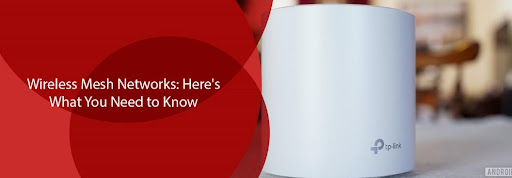
It wouldn’t be wrong to say that most of us are familiar with dead Wi-Fi zones – it’s a common drawback in many home networks. Well, it’s not hard to see ‘why’; depending on your router location, there could be many corners at your home where your Wi-Fi is unable to provide proper signal coverage. Obviously, this can occur due to a number of reasons, such as wall blockage, signal interferences with other devices, your router placed too far away, etc.
However, the good news is that we have an ideal solution for this problem – with Mesh Wi-Fi Routers, now you can easily enjoy 24/7 stable internet connectivity in all corners of your house. The mesh network increases the speed of the internet signals and provides the users with improved coverage.
Here’s all you need to know about Mesh Wi-Fi routers.
What is a Mesh Wi-Fi Router?
Unlike traditional Wi-Fi routers, mesh routers rely on two more satellite routers to provide you with improved signal coverage. These routers share the signal load and distribute it evenly in the unreachable areas while sharing the same SSID and network.
Generally, the mesh router systems provide two or three elements that work as nodes, hence providing you with better coverage in all corners of your house. Depending on your router model and brand, sometimes one node serves as the main router, while the others work as satellites. In other cases, all the mesh routers are interchangeable.
In order to enjoy ideal internet coverage, you need to plug one unit into your internet router or modem and place the remaining satellites around your house to ensure stable internet connectivity. Just like Wi-Fi extenders, mesh routers are also positioned close to one other so that they can interact with each other actively – but, at the same time, they are also at an adequate distance so that the signals can spread evenly in your total coverage areas.
Interestingly, only one node needs an internet connection – each node that you add to the mesh network will automatically catch the internet signals from the first node. However, the only key here is to connect to a high-coverage internet connection before investing in a mesh network, so that you can enjoy even improved internet connectivity at all times.
Spectrum provides robust, high-speed internet connectivity to all its users at super-economical rates. Besides this, Spectrum also offers exclusive TV services to maximize streaming fun. So, just in case, you are looking for a high-coverage TV plan, then don’t forget to check out the latest Spectrum Select TV plan. It offers more than 125 channels to all its users at only $49.99 per month, along with a 30-day money-back guarantee.
For more information, please reach out to Spectrum’s official website, or simply call their official customer services helpline.
What Are the Benefits?
Undoubtedly, mesh networks offer a wide range of benefits to enhance your overall signal coverage and range. Here is a quick glimpse of some of its other benefits:
- Additional Network Points — The fact that each network point in your house produces its own internet signals, certainly indicates that you can stay online, even if any point goes down. You do not need to replace or repair any part of your network in case of weak signals. Instead, the rest of the points should help you stay online for your continued use in case of network instability. You can even add extra points to your network if you wish to enjoy more powerful signals.
- Stable Connectivity — Unlike extender setups or traditional routers, mesh Wi-Fi networks spread their signals evenly in all directions. This means that you would always be able to enjoy the fastest signal in each corner of your home, regardless of wherever you are sitting. In simpler words, it works like shipping packages – the more routes it has, the faster it would get to you.
- Easy-to-Use — Mesh Wi-Fi networks offer extremely convenient controls to the users. It features a pretty simple and easy-to-use design – once installed, you don’t need to alter its settings again and again. Instead, you can simply rely on its high-end in-built tech to provide you with flawless internet connectivity everywhere in your house.
Are There Any Drawbacks?
Just like every other tech product on the market, mesh networks also offer some major drawbacks. Here are some of them:
- Expensive — Mesh networks aren’t a cheap option at all – it consists of some expensive components that cost about $200 just to get off the ground. Besides this, you are going to need another $100 or $200 for adding any additional network point. But on the other hand, many traditional routers cost less than fifty dollars each.
- Requires Several Access Points — Having multiple access points certainly means that you will need to plug each one into the outlet. Although it’s not a big deal for some people, still just think about how many other tech devices like smart speakers, lamps, or PCs you need to plug into your power outlets at any given time. So, there’s a high chance that you need to invest in a few power surge protectors to create some space for access points.
- Excessive Coverage Range — Mesh networks tend to place a blanket of extremely high-coverage signals over all else – so, although you might be able to connect more devices over wide ranges, still you would end up losing some of the top-end speeds. Not only that, but you would also receive more coverage than you need because obviously, not all of us require a 3,000 or more square feet coverage range. Right?
The Bottom-Line
We hope you benefit from the above-mentioned features and pros and cons of Mesh Wi-Fi Networks.
However, if you wish to know more about the specifications, and advantages of Mesh Wi-Fi Networks, then please reach out to some reliable tech websites on the internet. But first, just ensure that you are connected to a high-coverage internet connection so that you can avoid the usual network congestion while browsing.
Also, if you are looking for some high-speed, yet economical internet plans for yourself, then do check out the latest internet deals from BuyTVInternetPhone.







